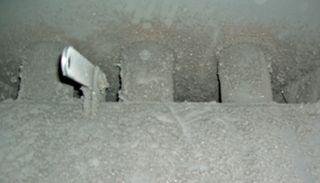
by blogediter | May 4, 2018 | Chimney Plugs
Heatilator
Q: Hi, I stumbled across your site today, and I am very interested in one of your Chimney Balloons. I have a question. My chimney has a system to take cold air off the floor in front of the hearth, and draw it through some pipes that run through the flue. This warm air is then fan forced out above the fireplace. The question is whether your Chimney Balloon will go between these pipes and the damper, or squeeze through between the pipes, and be inflated above them. I can take a digital picture and send or maybe take some measurements and send those… – CF
A: CF, Most people refer to those systems as heatilators (but that is a brand name.) A deflated Chimney Balloon needs a gap of 2″ to 2.5″ to fit through. Once you are through these pipes you should be good to go. I would suggest using a folding carpenters ruler to measure above the pipes so you can tell how large a Chimney Balloon you need. You may need to consider an extension for your Chimney Balloon if you plan on reaching very far past the heatilator pipes to inflate the Chimney Balloon. The Handle/valve Extender kit (HEK) will give you an extra 16″ of reach to add to your 12″ Chimney Balloon handle. You can see those extenders on the Buy Chimney Balloon page.
Below is an image of one and this is a link to the Chimney Balloon Blog entry on how to use the HEK Extender. http://www.chimneyballoonusa.com/blog/using_a_hek_extender/index.html
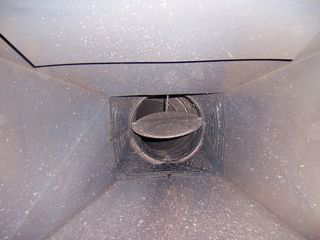
by blogediter | Apr 30, 2018 | Chimney Plugs
Flue Walls Slant
Q: Inside my fireplace, about 29″ up from above the opening is the damper. Just below the damper and each of the four sides or slit type openings. I do not know why. Maybe for air? I just saw the picture from SH and that is what mine likes like except all 4 sides slant in. It is about 10×10 at the damper. – KT
A: Dear KT, Since the sides slant on all 4 sides we will have to do the install high or low. We can use a HEK extender and a small 12×12 Chimney Balloon to install above the damper, or we can use the ledge that is generally just on the lintel and install a larger 36×15 Chimney Balloon. The lower install is easier but the balloon may be slightly visible from the room. _ Jason
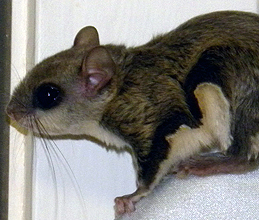
by blogediter | Apr 27, 2018 | Chimney Plugs
Chimney Balloons to squirrel, raccoon, opossums and larger vermin.
Q: Jason, A couple of times in the last few years we’ve had flying squirrels come down the chimney.
How resistant are the Chimney Balloons to the claws of little critters such as this? (I would put a screen on top of the chimney but I’d have to rent a lift to do so. Tall house, taller chimney, steep roof…) Thanks, – ADH
A: Dear ADH, Have you got a friend with a bucket truck or cherry picker? No?, neither do I, but I wish I did many times.
Chimney Balloons hold up well keeping out birds, bats, insects, and wasps, but they fall short when it comes to raccoons, squirrels, mice, and opossums.
If the critter has teeth and claws, you are going to need a wire mesh cap on the chimney and I would spend the extra to get a stainless one so you don’t have to replace it soon. Don’t risk your neck on your steep roof, call a chimney sweep to put the cap on for you. And if it is opossums or raccoons you are trying to keep out of your chimney make sure you anchor it VERY well. Those critters have the strength of a Gorilla when it comes to removing chimney caps! – Jason
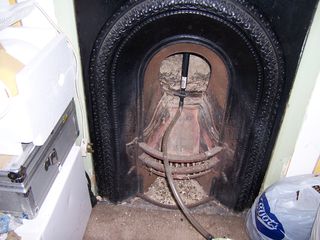
by blogediter | Apr 23, 2018 | Chimney Plugs, Fireplaces
Air seal a small coal burner fireplace
Q: I have an old coal fireplace, with a cast iron insert. The chimney itself has no damper but the insert does have a narrow flap that I suppose is used as a damper (though a very inefficient one when it the fireplace is not in use). I had to slide the insert out to see what the chimney looks like from the inside, as there was no way to see through the damper slot (which measure about 20″x2″).
The highest and narrowest part of the chimney is 9″x9″. Then it looks like it’s relatively straight/slightly sloping at about 9″x15″. And then slopes again over about 20″ to it’s the largest point of 9″x20″, just above that damper slot in the insert.
From what I’ve read, you don’t recommend positioning the Chimney Balloon on the slope. I’m almost positive I wouldn’t be able to get the Chimney Balloon up to the 9×9 spot (certainly not without removing the insert every time, which I want to avoid).
So, a bunch of questions:
1. What’s the likelihood of me being able to maneuver the Chimney Balloon through the damper slot in the insert?
2. What’s my best position?
3. Related to #2, what’s my best sizing?
4. Oh, and I think the 9″ is really more like 9.25… how exactly are you Chimney Balloon sizes?
Thanks for your help! – ZE
A: Dear ZE, We spoke on the phone briefly about how your coal inserts slide into the fireplace. Considering there is significant clearance between the top of the insert and the 9×9 fireplace flue area, you will find the 9×15 area to be the best location to install the Chimney Balloon. I understand the walls of this area taper upward on two sides and are vertical on two sides in this area. The Chimney Balloon will grab and hold firm on the two parallel and vertical walls, and it will seal the two slanted walls as well.
Once in place, it is possible to uninstall the Chimney Balloon through the very small 2″ damper opening, but honestly, it is not easy to do. You will have to reach the Chimney Balloon through the damper so you can open the air valve. Once the air valve is open you will have to give the Chimney Balloon 5 minutes or more to release its air. Then you slowly and carefully thread it down through the damper little by little. Fortunately, a 9×15 is a relatively small Chimney Balloon, so there is not a lot of Chimney Balloon material.
If I can be of further assistance to you in this coal fireplace insert application please let me know. – Jason
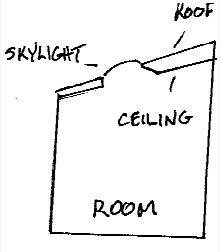
by blogediter | Apr 14, 2018 | Chimney Plugs
Plugging a skylight chute
Q: Jason, I understand the application of a Chimney Balloon is to plug a Chimney flue but is it possible to plug a skylight chute with a Chimney Balloon?
I have this skylight on my roof that leaks in cold air like crazy. When you stand under the skylight in the winter you can actually feel the cold air fall on you, so I can imagine the heat I am loosing is significant.
I have looked high and low for a plug for this skylight chute since I really need to plug it, but I don’t want to remove it. Can I get a Chimney Balloon made that will fit this application? I drew a diagram of the chute (see images) – TR
A: Dear TR, This is a bit unorthodox use of a Chimney Balloon, but yes you can use it to plug a skylight chute. The membrane of a Chimney Balloon will degrade a little more rapidly with the exposure to the UV rays, but if you wanted to diminish that impact you could put a UV film on the skylight before installing the Chimney Balloon. Also, we will make the interior retainer ring out of Viton since our regular rubber retainers will also degrade with exposure to UV.
A custom 22×49 would be the right size according to your diagrams. Go a few inches oversized in length since the chute wall slopes out – Jason

by blogediter | Apr 11, 2018 | Chimney Plugs
Since we’ve already done our measurement and we know we have a 9-inch Rome flue, we know also that we would use a standard size Chimella.
The Chimella is very durable and it installs with a push of a button. It also uninstalls with a push button. You can recapture it.
You have to put the Chimella in pass the damper and then hit the up button and then reach up and push the collar forward to tighten up the Chimella lock. Tighten up the collar to make sure it’s a snug fit.





